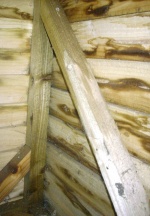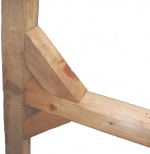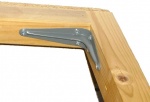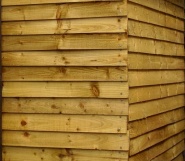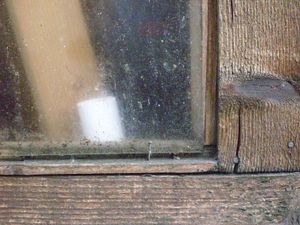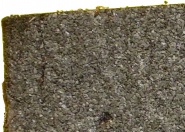Shed
DIY or kit?
Sheds can be bought in kit form or built from scratch.
Kits are:
- quick to assemble
- usually weak
- benefit from reinforcement
- poor ability to support shelving
Self designed sheds:
- no cheaper to DIY
- you get a much more robust result
- you can have whatever size & shape you want
- whatever style you want
- whatever design features you want.
Timber sources
- Diy Sheds (Wickes, B&Q etc)
- Timber merchants
- Pallets
- spend the money on a suitable saw and using a garden felled tree. Lot more work
- Sawmill offcuts
For the last 2, sufficiently thorough wood preservation isn't really workable at home, and durable timber species should be used.
Construction
While there are many ways to build sheds, the great majority are wooden and contain the following elements:
- Base
- Floor
- Frame
- Cladding
- Window
- Door
- Roof sheeting
- Felt
(Base and floor functions are sometimes separate, and sometimes both performed by the same item.)
Base
In each case where a timber frame rests on masonry, its best to put a damp barrier between base and timber. A roofing felt offcut can be used for this. These barriers are often omitted, but can reduce the tendency to rot.
Poured concrete base
- a very durable permanent structure
Construction:
- 4" concrete recommended
- 3" is a lot weaker, but sometimes used
- Concrete usually laid on compacted ground & hardcore
- final concrete level should be above ground level
- See Mortar Mixes
Damp:
- Concrete conducts damp
- A DPC within the slab is not necessary, but can keep the shed interior drier
- a waterproofing admix might also work
Recommended base construction:
- hardcore or MOT 1
- sand blinding layer to prevent DPC damage
- DPC
- 4" of concrete, same size as shed not larger, and no reinforcement
Brick or block piers
- used for suspended timber floors
- the risk of a pier or 2 sinking is always present
- pouring a small concrete pad for each pier reduces this risk
Concrete fence posts, horizontal
- A quick easy option for use with a suspended timber floor
- cost higher than blocks
- Ideally use weed control fabric due to low clearance
- Damaged posts can often be bought
Paving slabs
- quicker than a poured base
- some risk of unevenness occuring over time
- the joints let in some damp
- Joints may be tarred to reduce damp ingress
- slabs are usually laid on compacted sand
Timber fence posts
Laid horizontally
- Works ok if they can be kept dry
- Sitting them on gravel works ok
Plastic base
- More expensive than DIY options
- Its possible to use plastic pallets instead
- Can be good on ground prone to standing water
No base
- Not recommended, lets in significant damp, and encourages wood rot
- damp spoils stored goods.
Floor
Concrete base
A concrete base also acts as a floor.
Suspended timber floor
- WBP plywood recommended
- Chipboard is totally unsuitable
- Lightweight block can be sawn to provide intermediate support blocks, enabling use of cheaper thinner flooring. Bricks also work, but can cause condensation where they touch the floor.
Damp control
Some sheds have no form of damp control. The result is rotting wood, mouldy fabrics if stored, rusting steel etc.
Void
A simple means to control damp is to create an open void under the shed. Damp evaporating from the earth is blown away.
Waterproofers
Waterproofers such as bitumen can be painted on top of a concrete slab.
DPMs
Damp prooof membranes, whether housebuilding types or roofing felt, can go under a shed to stop damp from the ground, or under a concrete base.
Walls
Once damp from the ground is controlled, for further dryness the shed must keep out rain laden air. Walls can be lined with any of polystyrene, DPM, OSB etc.
Some insulation is advisable to avoid external temp drops causing condensation. A simple way to achieve both aims is to put polystyrene between the uprights, taking care to seal gaps. Don't forget the roof too.
Active drying
Once ground damp is blocked and the walls insulated, there are ways to further dry the interior:
- Heating. The most expensive option
- Dehumidifier. Compressor types only work in the teens centigrade upwards, so a dessicant wheel type is needed. These cost more and use more energy
- Passive chemical dehumidifiers, eg a tray of lime chips, don't absorb enough water vapour to be of use
Frame
There is no one answer to the question of what size framework to use. Any of the following can be used, and which is best is a matter of opinion and circumstance.
- 1"x1" is the lightest I've ever seen used for smaller sheds. The walls would bend when leant on
- Would not support shelving
- Would not last too well
- Not recommended!
- 2"x2" is light but adequate for a small shed in a fairly sheltered location.
- 2"x4" is a robust option
- 3"x3" or 4"x4" may be used for medium to large sheds, sheds in exposed locations, or for extra durability.
Pallet frames are occasionally used. These are salvaged pallets nailed together. A cheap option that's less easy to construct. Nails in the wood restrict sawing options.
Restraint
Rectangular timber frames can twist and fall over if not restrained. Movement pulls the fixings apart, permitting further movement until the structure falls down or leans. Some form of restraint is necessary.
Timber bracing is the usual method, either with small or large bracing.
Sheds built onto 2 masonry walls will be restrained by those walls, and need little bracing. Sheds built onto one masonry wall still need some bracing.
Effective bracing needs to be done on at least 3 sides. 2 side bracing does not rigidify a frame structure. Maximum strength is achieved by bracing all sides.
Masonry sheds don't need bracing, but often need piers to ensure wall stability.
Methods:
Large timber bracing
- Each square frame is braced with a strip of wood running from one corner to the opposite corner.
- Simple
- Gets in the way of insulation, some shelving and hanging tools
- The most strong & rigid type of bracing
Small Wooden bracing
- Each 90 degree timber joint is reinforced with a short piece of extra timber at 45 degrees
- no material cost, offcuts are used
- less intrusive
Sheet bracing
Large sheet material fixed to the framework has a bracing effect, and further bracing isn't then needed. Sheet may be used to aid fixing to walls, or to conserve heat along with insulation.
Steel brackets
- London brackets are a quick ready made option
- These stiffen the structure, but generally aren't as tough as timber bracing.
Cladding
The frame may be clad with various options to give a closed structure.
Featheredge boards
- the most common option
- medium durability
- gaps at corners allow airflow, draught & insect access
- gaps soon open up between boards
Tongue & groove
- neater higher cost option
- no gaps, not draughty
- pic
- be sure to mount them tongues up so the grooves dont collect water
Shiplap
Another style of tongue & groove
Fence panels
- a very quick low cost option
- the shed must be sized to fit the panels used
- less durable than featheredge
- not as strong, can be a security issue
Planks
- 1" plank gives a very tough durable building.
Window
A shed window is usually a simple rectangular wood frame with a small section wood strip around the inner side to prevent the glass moving inward. A few panel pins around the edge hold the glazing in place.
Wood beading can be used instead of pins, but by trapping water this encourages rot in the frame.
Reusing a house window works, but tends to look rather out of place, and creates extra work if the glass gets broken.
Materials
Windows can be made from:
- Sheet glass - breakable
- Sheet plastic (acrylic)
- less easy to break once fitted
- easy to break during cutting
- can deteriorate in time
- Twinwall polycarbonate - Insulates, pricey
- Reclaimed house window - looks odd in the typical small timber shed
Window position
Visibility
Windows at conventional eye level mean the contents can be visible from the outside, which can sometimes be a security issue. White curtains can be added, either on tracks or just stapled in place.
Sun
Windows that receive afternoon sun will give more light in the shed, but this will cause heating in summer, elevating summer temps further. Windows that don't get direct sun avoid adding further summer heating.
Gable windows
]]
Triangular windows under the roof slope require no more work than rectangular ones, and eliminate the cutting of several featheredge strips. These can be frameless, with acrylic sheet simply screwed in place. The small roof overhang prevents water penetration along the top, and the bottom of the plastic is over the outside of the timber cladding.
The plastic is drilled and screwed in place. Go gently when drilling acrylic, it cracks easily. Don't tighten the screws, or the plastic will crack. Fixing holes should be a little larger than screw shanks so that shed movement doesn't break the window.
When roofing felt is used with minimal roof overhang, the felt overlaps the top of the plastic window. In these cases, the layers of felt and the clear plastic can be holed in one by using a die grinder with a small grind stone, which quickly melts through all the layers in one go. One row of screws then fixes both felt layers and window. (When die grinder drilling this way, retract the tool as soon as it goes through, the plastic can re-set quickly)
The one pictured is frameless, and quicker than a traditional framed window. Click the photo (and click it again) to see the details up close.
Strip windows
Window strips, which are long thin strips of plastic used in place of a strip of featheredge, can limit view of contents if placed high up near the roof. The advantage is that no window frame is required. The plastic should be at least 4mm thick. However viewable contents is only one of several security issues with sheds. If such windows are fitted at the right level on a shed with roof overhang, the overhang can block direct summer sun while allowing some winter sun in.
Soffit windows
If the roof is made a bit wider than the shed walls, clear plastic sheet can be used as soffit. This gives light without any view of contents, and with no direct sun to heat the shed further.
Custom
Its also possible to fit decoratively shaped windows, and these can add wanted character to a shed close to the house.
Door
Ledged & braced is by far the most common shed door construction
Timber:
- T&G is usually used, but any thin planks are usable.
- T&G avoids gaps opening up due to warping
- When not using T&G, additional light bracing is recommended to address warping
- the horizontal ledges may be 2x1.5 or bigger
- bracing may be 2x0.5 or bigger
Construction:
- The thin planks are laid side by side.
- They are screwed or nailed to 3 wood strips (ledges) running across, one at the top, one at the bottom, and one halfway up the door
- 1 or 2 bracing strips are added at an angle on the inner side of the door to prevent it drooping on one side
Roof sheet(s)
The options are:
- timber based sheets plus felt
- corrugated sheet, available in various materials
Pitched roofs should overhang the shed. This way they shed rain water away from the walls, helping prevent rot.
Timber sheets
Felt
2 layers of roofing felt are used for durability.
Low cost shed felts tend not to last well, and are generally a false economy.
Felt deteriorates quickest where it goes over edges, so taking care over sheet wood joints can prolong felt life.
Felt is held in place by folding it over the edge of the roof and using clout nails. Self adhesive felts are also available.
Clout nails are prone to lifting out, waferhead screws aren't. Some people find waferheads easier to install.
Better alternatives to felt are available, but carry a much higher price tag, not usually justifiable for a small shed.
For a temporary roof cover, a single layer of felt on chipboard can last years.
Fixing felt
There are 3 ways to fix felt:
- Self adhesive felts
- nails - fold felt over roof edges and nail there
- bitumen emulsion - paraffin thins it and cleans it off
- clout nails are often used on the roof slope too, but they're prone to letting in water there
Corrugated roofs
Corrugated sheet is available in various materials, including:
- clear plastic
- opaque plastic
- composition (eg onduline)
- Steel
- fibre cement
Clear plastic roofing eliminates the need for other windows, but makes for an excessively hot shed in summer unless kept to a small percentage of roof area. A white shower curtain may be fixed underneath to reduce this effect to a degree, and prevent people seeing into the shed.
Plastics and composition sheets are low strength and need good support from battens.
Metal roofs are noisy in rain, which is a consideration for sheds that will be used as workshops. Some people aren't concerned by a little noise, some are quite bothered by it (it gets pretty noisy in hail).
Construction
All corrugated materials are fixed by screwing through the sheets and into the timber (or sometimes metal) frame. Screws with pre-attached soft caps are used, the cap material squashes and makes the join watertight. Put screws in at the corrugation peaks, not in the valleys.
Sharp pointed screws are used for timber and lightweight steel frame, self drilling screws are used for most metal frames.
The edges of corrugated panels are overlapped to maintain watertightness. Panels are fitted at the lowest part of the roof first, with the next layer up overlapping these.
Corrugated panels create large gaps at the ridge line, and the ridge is usually capped with purpose made matching capping sheets - eg onduline. (Lead flashing is expensive, thievable and much slower to install.
Timber Species
Spruce (whitewood)
- popular
- low cost
- requires periodic preservative
- rots eventually
Pine (redwood)
- absorbs preservative better than spruce
- lasts longer
Red cedar
- much more durable than softwoods
Oak
- rarely used but highly durable. Can last centuries
Rot prevention
Softwood should be pressure treated.
Where frame or floor sits on bricks or concrete blocks, the latter conduct cold and cause condensation, hastening rot. Lightweight blocks don't cause condensation.
Optional Extras
Frame Reinforcement
- Increases robustness against high winds by reinforcing framing joints
- Resists nail pullout at joints
Steel strapping
- Perforated galvanised metal band is wrapped around joints and nailed in place
- Useful in high wind exposed locations.
Bracing
Any type of bracing will toughen the frame considerably. This is usually the best way to go, as it rigidifes and strengthens in one go.
Screws
Screws resist pullout better than nails, giving a frame more robust against storm winds. But you wouldn't want to build a shed with a manual screwdriver :)
Insulation
If the shed will be used for working in, polystyrene sheet may be fitted between the frame members. Take care to eliminate gpas in the insulation layer. When using featheredge boards for exterior cladding, which leave gaps, a permeable membrane should be used between frame and exterior boarding to prevent draughts.
Shelving Racks
See Shelving Units
Lighting
Lighting may be achieved with:
- Gas lamp
- minimal install cost
- ventilation is wise (the usual featheredge sheds provide ventilation)
- Mains Electricity
- Solar panel, battery, 12v striplight
- Battery light, taking batteries indoors to recharge them. Not the best options, batteries will be found to be flat at times.
- Low voltage light run off wallwart. LV is fed by bellwire from the house
Waterproof Base
A waterproof concrete mix for the base can reduce damp levels in the shed when these bases are used. Coating the base is also an option.
Fixings
- Galvanised nails are the usual option
- Screws hold better and are more robust in areas prone to high winds or vandalism.
- Glued structures are not likely to succeed
Other Construction Methods
Most sheds are timber, but various other options also exist.
Common options:
- Concrete block
- permanent structure
- Metal
- fireproof
- dents & rusts
- expect condensation
- Plastic
- weak
- rust & rot proof
- Fibre cement sheet
- long lived but not cheap
- pre-1986 fibre cement usually contains asbestos
Unusual options:
- Papercrete - tough, durable & cheap, but requires a big paddle mixer, wooden form & plenty of labour
- Cordwood - pretty, uses a lot of wood
- Adobe - thick walls & plenty of labour
- Earthcrete - minimal cost, but lot of labour
- Concrete domes - odd shape, requires a suitable form. Domes only become self supporting and stable once completed.
Papercrete
Papercrete is one option that offers very different properties and results to the typical timber shed. Its been used a fair bit in the South US, and on occasion in subzero locations, and has proved durable in both.
Papercrete is a lightweight cellulose cement product, made with pulped scrap paper, cement and sand. Sheds can be built using poured walls, blocks, or rendered wire mesh. Its popular to take advantage of papercrete's properties and make buildings arched, sculpted, rounded, domed and so on, and to form various nontraditional decorative features on the building.
Small pieces of glass can be cemented directly into the papercrete. Bottles have often been used, clear or coloured, and decorative glass plates etc have been moulded in with good effect.
Papercrete survives wetness fine, but absorbs water like a sponge, so suitable damp control is necessary all round. It has very good fire resistance, but once it is finally got to smoulder, it tends to keep smouldering for many hours, and is eventually eaten away.
